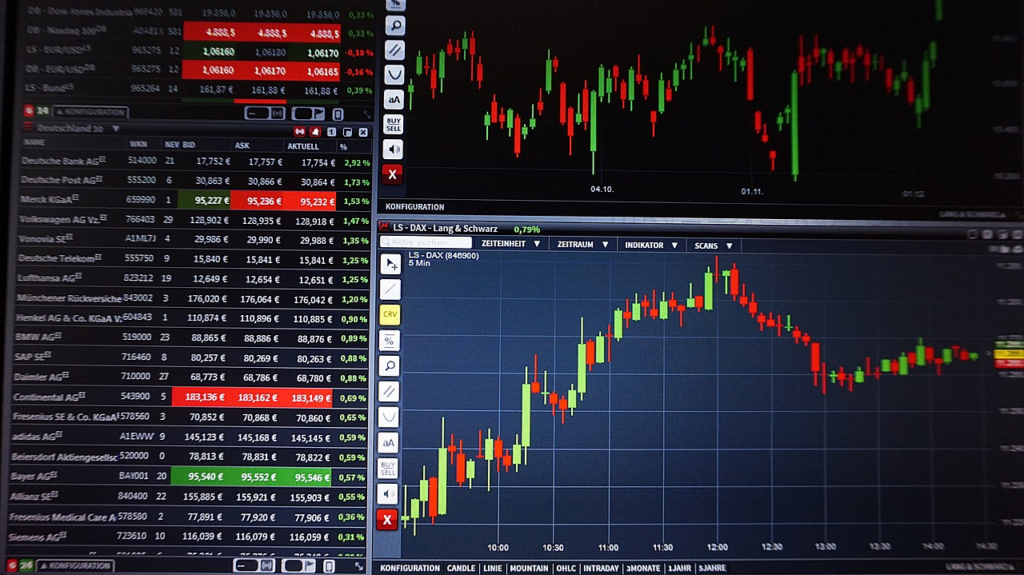Advertisement
Investing in dividend-paying stocks is a popular strategy among many investors, as it offers a way of generating passive income while remaining exposed to the growth potential of the stock market. Dividends are regular payments made by companies to shareholders as a share of distributed profits.
What are dividends?
Dividends are a portion of a company's profits that are distributed to its shareholders as a way of rewarding them for their investment in the company. When a company makes a profit, it can choose to reinvest this money in the business to finance future growth or distribute it to shareholders in the form of dividends. This distribution of profits is decided by the company's board of directors and is usually approved by the shareholders at a general meeting.
Advertisement
Dividends can be paid on a regular basis, such as quarterly or annually, and are usually expressed in terms of a cash value per share. For example, a company may declare a dividend of $0.50 per share for each shareholder.
Dividends can be an important part of a stock investment's total return, especially for investors looking to generate passive income. Many investors, especially those approaching retirement, rely on dividends as a stable source of income.
Advertisement
It is important to note that not all companies pay dividends and that the decision to distribute profits in the form of dividends depends on the company's dividend policy, as well as its financial situation and business strategy. Some companies choose to reinvest all their profits back into the business to finance growth, while others prefer to return part of those profits to shareholders in the form of dividends.
Dividends can also be an indication of a company's financial health and performance. Companies that consistently pay dividends over time demonstrate financial stability and the ability to generate cash flow, which can be seen as a positive sign by investors.

Why do investors look for dividend-paying stocks?
Investors look for dividend-paying stocks for various reasons, and this strategy is popular with a wide range of investors, from beginners to the most experienced. Here are some of the main reasons why investors look for dividend-paying stocks:
Passive Income
One of the main reasons why investors look for dividend-paying stocks is to generate passive income. Dividends provide a regular source of income that can help supplement other sources of income, such as salaries or income from other investments. This is especially attractive for investors who are approaching retirement or looking to build a portfolio that provides a consistent cash flow over time.
Stability and Consistency
Companies that pay dividends consistently over time are often seen as more stable and reliable. Regular dividend payments can be a sign of a company's financial health and stability, as it requires a consistent and predictable cash flow. This can be reassuring for investors, especially in times of market volatility.
Profit sharing
Dividends allow investors to participate directly in the profits of the companies in which they invest. Instead of relying exclusively on share price appreciation to make a profit, investors can receive a share of the company's profits in the form of dividends. This allows investors to obtain financial returns even without selling their shares.
Growth History
Companies that have a history of regularly increasing their dividends over time are highly valued by investors. Increasing dividends can be a sign that the company is thriving and generating consistent profits.
Investors often look for companies with a history of dividend growth because this can indicate effective management, financial strength and a solid business model.
Inflation protection
Dividends can offer some protection against inflation. As dividends tend to increase over time, they can help investors maintain the purchasing power of their income, even when the prices of goods and services are rising.
Which shares pay the highest dividends?
Although the companies that pay dividends can vary over time and depend on various factors, some stocks have historically stood out for their high dividend yields. Some of these include:
AT&T (T)
(NYSE: T) is one of the largest telecommunications companies in the world and one of the industry leaders in the United States. Founded in 1983, AT&T has a long and rich history of providing communications services, including landline telephony, internet services, pay-TV and more. Over the years, the company has expanded its operations and diversified to become a comprehensive communications and entertainment provider.
History and Evolution
AT&T dates back to the American Telephone and Telegraph Company, founded in 1885 after the invention of the telephone by Alexander Graham Bell. Over the decades, the company has grown and established itself as one of the leading providers of telephone services in the United States. In 1984, following an antitrust lawsuit, AT&T was split into several regional companies known as Baby Bells. However, the original AT&T continued as a long-distance and communications company.
Since then, AT&T has undergone several transformations and expansions, including significant acquisitions and entry into new markets. One of AT&T's most notable acquisitions was the purchase of DirecTV in 2015, which expanded its reach in the pay-TV market. In addition, in 2018, AT&T completed the acquisition of Time Warner, now known as WarnerMedia, further strengthening its position as an end-to-end communications and entertainment company.
Johnson & Johnson (JNJ)
Johnson & Johnson (J&J) is one of the world's largest diversified healthcare companies, known for its trusted brands and global presence. Founded in 1886 by brothers Robert Wood Johnson, James Wood Johnson and Edward Mead Johnson, J&J began as a medical surgical products manufacturing company. Over the years, it has expanded its operations and become a global company, a leader in various healthcare sectors.
Innovation and Research
J&J has a solid commitment to innovation and research, investing significantly in R&D (Research and Development) to drive the advancement of new therapies, medical technologies and consumer products. The company has an extensive network of research centers and collaborations with universities and academic institutions around the world, constantly seeking new discoveries that can improve people's health and well-being.
Exxon Mobil (XOM)
Exxon Mobil Corporation (NYSE: XOM) is one of the world's largest integrated energy companies, involved in all phases of the oil and gas value chain, from exploration and production to refining and marketing of petroleum products. Founded in 1999 through the merger of Exxon Corporation and Mobil Corporation, ExxonMobil has a long history and a significant global presence in the energy sector.
Exploration and Production
One of Exxon Mobil's main business pillars is the exploration and production of oil and natural gas. The company operates in various regions of the world, including North America, Latin America, Europe, Africa, Asia-Pacific and the Middle East. It has an extensive portfolio of assets, including onshore and offshore oil fields, as well as natural gas reserves.
Refining and Marketing
In addition to exploration and production, Exxon Mobil is also involved in refining crude oil and producing a variety of oil-based products, including gasoline, diesel, kerosene, lubricants and chemicals. The company operates refineries all over the world and has an extensive distribution network to market its products.
Procter & Gamble (PG)
The Procter & Gamble Company (NYSE: PG) is one of the world's largest consumer goods companies, with a global presence in a wide range of product categories. Founded in 1837 by William Procter and James Gamble, P&G has a rich history and an established reputation for providing high-quality products that improve the lives of people around the world.
Product Diversification
One of Procter & Gamble's main characteristics is its extensive range of brands and products, covering several categories, including home care, personal care, oral health, baby care, feminine care, hygiene products and much more. Some of P&G's most recognizable brands include Pampers, Gillette, Crest, Tide, Pantene, Olay, Always and Oral-B, among many others.
Innovation and Research
P&G has an ongoing commitment to innovation and research, investing in R&D (Research and Development) to develop new products and improve existing ones. The company has an extensive network of innovation centers and collaborations with universities and research institutions around the world, aimed at identifying market trends, understanding consumer needs and creating innovative products that meet those needs.
What should investors consider when investing in dividend-paying stocks?
When investing in dividend-paying stocks, investors should consider a variety of factors in order to make informed decisions in line with their financial objectives.
Dividend History
Evaluate the company's dividend history, including its consistency and growth over time. Companies that have a solid history of paying dividends can be more reliable and stable, providing a consistent source of income for investors.
Financial Health
Analyze the company's financial health, including its ability to generate sufficient cash flow to support dividend payments. Also check the company's level of debt and its ability to meet its financial commitments.
Growth prospects
Consider the company's growth prospects and its ability to maintain or increase its dividends in the future. Companies with resilient business models, solid competitive advantages and growth potential can offer more sustainable dividend opportunities in the long term.
Sector and Competition
Evaluate the sector in which the company operates and its competitive position in relation to its competitors. Stable and defensive sectors, such as consumer staples, healthcare and public services, generally have companies that pay consistent dividends. However, it is important to consider the competitive environment and industry trends that could affect the company's long-term performance.
Dividend Payout Ratio
Analyze the company's dividend payout ratio, which is the proportion of profits that the company distributes to shareholders in the form of dividends. A healthy payout ratio usually indicates that the company has room to increase its dividends in the future, while a very high ratio can signal that current dividends are unsustainable.
Dividend Policy
Understand the company's dividend policy and how it decides the amount and regularity of dividend payments. Some companies have a more conservative dividend policy, while others may distribute most of their profits to shareholders. Understanding the company's dividend strategy can help investors make more informed decisions.
Action Evaluation
Consider the valuation of the stock in relation to its price and intrinsic value. Investing in dividend-paying stocks can be attractive, but investors should also ensure that they are not paying too high a price for the stock in relation to the amount they expect to receive from dividends over time.

Diversification
As with any investment strategy, diversification is key when investing in dividend-paying stocks. Distributing capital among various companies and sectors can help reduce risk and increase return opportunities over time.
By considering these factors and conducting a careful analysis, investors can identify investment opportunities in dividend-paying stocks that align with their financial objectives and risk tolerance. However, it is important to remember that investing in stocks involves risks and that dividends are not guaranteed, so proper due diligence is essential to making informed and prudent decisions.
An effective strategy for investors
Investing in dividend-paying shares can be an effective strategy for investors looking to generate passive income and participate directly in the profits of the companies in which they invest.
However, it is important that investors carry out proper due diligence and consider a variety of factors before making investment decisions. By doing so, investors can find opportunities that offer a balance between current income and future growth potential.
See also: Rent Adjustment: How much is allowed by law?
March 31, 2024

She has a degree in Languages - Portuguese/English, and is the creator of the Escritora de Sucesso website. As a writer, she seeks to expand everyone's knowledge with relevant information on various subjects. At SoMuchToSayToday, she brings news and content ranging from entertainment to the country's economic situation.



